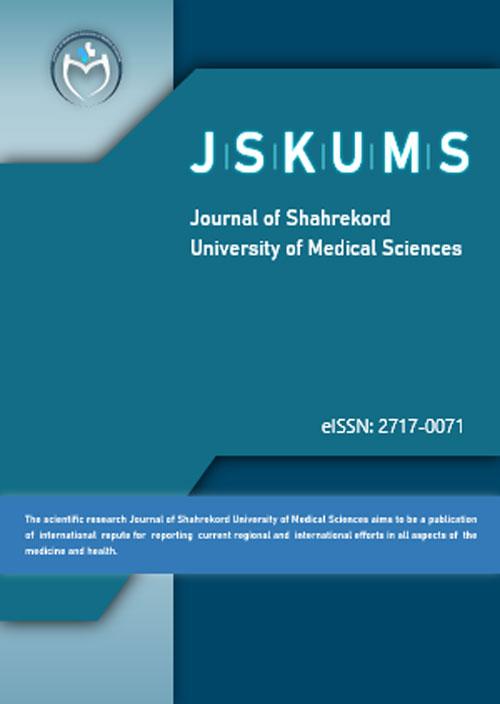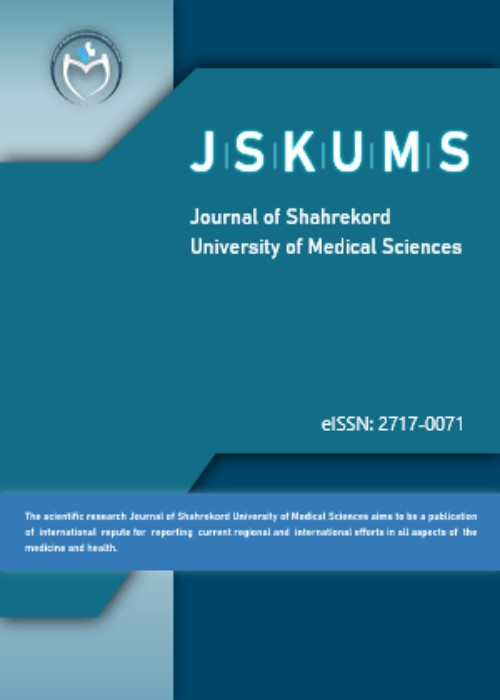فهرست مطالب

مجله دانشگاه علوم پزشکی شهرکرد
سال بیست و سوم شماره 2 (پیاپی 111، Spring 2021)
- تاریخ انتشار: 1400/05/03
- تعداد عناوین: 7
-
-
Pages 56-61Background and Aims
Pilonidal sinus in the sacrococcygeal region is a disease with high postoperative morbidity and discomfort for the patient. Although there are various therapeutic modalities to manage these patients, Controversy for choosing the best surgical technique in order to decrease the recurrence rate, patient discomfort, and Duration of disability after surgery still exists. Therefore, the objective of the present study was to compare results reached from two methods of surgery, tie-over procedure (TOP) and Karydakis procedure(KP) for the treatment of sacrococcygeal pilonidal sinus.
MethodsIn this study, 70 patients with a diagnosis of pilonidal sinus disease treated randomly with surgical excision and TOP or KP, in two 35 patients group, in the educational hospital by the same surgeon, between 2009 and 2010, and followed up until December 2019.
ResultsAchieved data after excision of sacrococcygeal pilonidal sinus indicate that primary closure of the wound by tie-over sutures have a better result than KP in order of Pain sore during the first month after surgery (P< 0.001), Duration of disability (P <0.001), wound repair time (P <0.001) and Patient satisfaction(P=0.019).
ConclusionOverall, these results show the TOP instead of KP, because higher acceptance results may be an alternative better for the treatment of chronic pilonidal sinus for the patients who have surgery scheduled for them.
Keywords: Sacrococcygeal pilonidal sinus, Suture techniques, Karydakis procedure, Tie-over procedure, Wound healing -
Pages 62-67Background and aims
Multiple sclerosis (MS) is a common neurological disorder with complex etiology, which is highly affected by psychological factors. These factors should to be identified to help patients with MS (PwMS). This study aimed to compare coping styles, personality traits, and resiliency in PwMS and healthy subjects.
MethodsIn this case-control study, we selected 75 PwMS from the members of Tehran MS Society in 2016 as case group and 75 healthy subjects as control group. To collect data, we used the Ways of Coping Questionnaire (WOCQ), Big Five Factor Inventory–Revised, and Conner-Davidson Resilience Scale (CD-RISC). Multivariate analysis of variance (MANOVA) and independent T-Test were used to analyze the data.
ResultsThe results indicated that PwMS use emotion-focused coping styles more often (44.53±9.13, P=0.008) and problem-focused coping styles less often (39.84±5.79, P=0.001) compared to control group. Also, they showed higher scores in neuroticism (32.10±4.80, P=0.001) and lower scores in extraversion and conscientiousness (27.46±7.12, P=0.005 and 32.98+±5.72, P=0.008, respectively). The resiliency levels in these patients were also lower than healthy subjects (68.13±13.90, P=0.021).
ConclusionOur findings indicated that PwMS are more likely to use emotional coping strategies in stressful situations compared to healthy individuals. Moreover, data confirmed that a maladaptive personality configuration, which is specified by high neuroticism, along with low extraversion, conscientiousness, and agreeableness are somehow related to MS.
Keywords: Coping strategies, Personality traits, Resiliency, Multiple sclerosis, MS, PwMS -
Pages 68-75Background and aims
Human interferon beta-1a (hIFNβ-1a) is a 22.5-kDa glycoprotein used to treat diseases such as multiple sclerosis (MS). Because of appropriate post-translation modifications, protein isolation, and lack of toxicity in Chinese hamster ovary (CHO) cells, we cloned hIFNβ-1a encoding sequence into these cells by recombinant DNA technology to achieve stable expression of this recombinant protein.
MethodsThe hIFNβ-1a encoding sequence was designed based on the CHO cells’ codon usage and the Gene Bank data, and then syntactically constructed in the pUC57 vector. After confirmation, the synthesized sequence was cloned into the pcDNA3.1 expression vector by using EcoRI and XhoI sites via Escherichia coli DH5α competent cells. Then, the recombinant vector pcDNA-hHIFNβ1a was linearized by BglII and transfected into the CHO cells using lipofectamine. The transfected cells were proliferated and screened by gentamicin. Certain concentrations of zinc sulfate, DMSO, and glycerol were used to enhance protein expression. Finally, the recombinant protein expression was qualitatively evaluated using different techniques.
ResultsThe hIFNβ1a integrity was confirmed by DNA sequencing and specific software. The construction and sub-cloning of hIFNβ1a-pcDNA3.1 in E. coli were confirmed by colony-PCR with specific primers and restriction enzyme mapping. The screening of transfected CHO cells was performed using gentamicin. The protein expression was confirmed by RT-PCR, MTT assay, SDS-PAGE, and Western blot. Comparison of the optimized and control samples demonstrated that chemical treatment enhanced the protein expression.
ConclusionWe achieved the stable clones of CHO cells expressing the active form of human interferon beta.
Keywords: hIFNβ-1a, CHO cells, pcDNA3.1 expression vector, lipofectamine, MTT assay -
Pages 76-80Background and aims
In acute lymphoblastic leukemia (ALL), large numbers of stem cells become lymphoblasts or lymphocytes. Among the genetic factors influencing cancer is the ADAM (a disintegrin and metalloprotease) gene family. Due to the important role of this family in cancer, this study aimed to compare the expression level of ADAM17 gene in patients with ALL and healthy individuals.
Material and MethodsIn this case-control study, 40 venous blood samples were taken from ALL patients referred to Omid hospital in Isfahan, Iran. Also, 40 venous blood samples were taken from healthy individuals in vitro. Lymphocyte isolation was performed using a ficol and cell RNA was isolated using an RNX-Plus kit. It was then converted to cDNA using the Yekta Tajhiz Azma kit. Finally, reverse transcription-polymerase chain reaction (RT-PCR) technique was used to evaluate the relative expression of ADAM17 gene in blood samples of healthy individuals and patients with leukemia, and the ratio was measured with the reference GAPDH gene. SPSS software version 22 and t test were used to analyze the data.
ResultsThe expression level of ADAM17 gene in patients with ALL compared to the control group showed a significant increase, which was statistically significant (P=0.043).
ConclusionIt seems that increasing the expression of ADAM17 gene in people with ALL is a suitable biomarker to diagnose this disease.
Keywords: ADAM17 gene, RT-PCR, Acute lymphoid leukemia, Biomarker -
Pages 81-86Background and aims
Infertility is one of the most common problems among couples. Generation of male germ cells from adult stem cells is a current promising priority of researchers. This study aimed to investigate the potential of human umbilical cord mesenchymal stem cells (hUMSCs) on the expression of male germ cell markers after isolating by this method.
MethodsThe hUMSCs was incubated with retinoic acid, testosterone, and conditioned medium (prepared from testicular cell cultures of 7-day-old mice) during 3 days. The bands were visualized and densitometry was accomplished using LI-COR Biosciences software.
ResultsThe high expression levels of C-KIT, DAZL, PIWIL2, and DDX4 in mRNA and protein levels were observed in treated hUMSCs.
ConclusionResults of reverse transcription polymerase chain reaction (RT-PCR) and western blotting showed that method of isolation had no adverse effects on differentiation potential of hUMSCs.
Keywords: Infertility, Human umbilical cord mesenchymal stem cell, Male germ cell, Retinoic acid -
Pages 87-92Background and aims
Synthetic organophosphates (OPs) inhibit acetylcholinesterase resulting in the accumulation of acetylcholine, failure of organs, and eventually death. Diisopropyl-fluorophosphatase (DFPase) is one of the OPs degrading enzymes that has broad substrate from OPs. In this study, for the first time, the secretory expression of DFPase in Bacillus subtilis was investigated in order to accelerate the biodegradation rate of OPs.
MethodsDFPase gene was amplified using polymerase chain reaction (PCR) from the pET28-inaV/N-dfpase plasmid. The PCR product was subcloned in the pWB980 plasmid. Competent B. subtilis WB600 were transformed with recombinant plasmid. SDS PAGE technique was used to study the expression of protein secreted in superrich medium.
ResultsAppearance of the 946 bp band in agarose gel after digestion of transformed plasmid confirmed the presence of DFPase gene in this construct. Approximately, 35 kDa protein band was shown in culture medium after incubating at 35°C for 72 hours and 150 rpm. Measurement of enzyme’s activity was done by monitoring the release of fluoride from diisopropyl fluorophosphate (DFP), using ion-meter. Results showed that enzyme’s activity was 3333 U/L.
ConclusionBacillus subtilis is a suitable host for production of secretory and active form of DFPase.
Keywords: Organophosphorus compounds, B. subtilis WB600, Secretory expression, DFPase -
Pages 93-98Background and aims
Antidepressant agents such as imipramine are clinically used to control and treat different types of pain, especially neuropathic pain. Studies have shown the antidepressant-like activity of folic acid (FA). This study aimed to investigate the potential antinociceptive effects of FA using formalin and acetic acid tests in male mice.
MethodsSixty male albino mice (20-30 g) were randomly divided into 10 groups (n=6 in each group) of negative control, positive control (morphine or indomethacin), and FA (10, 15, and 30 mg/kg) groups. In the formalin test, duration of paw licking and biting the right hind paw during acute (0-5 minutes) and chronic (15-60 minutes) pain after intraplantar injection of formalin 2.5% (25 µL) was recorded. In the writhing test, the abdominal constrictions were recorded after the intraperitoneal injection of acetic acid 1%.
ResultsOnly a high dose (30 mg/kg) of FA significantly reduced acute pain (P=0.001) compared with the control group. But all doses of FA significantly decreased chronic pain (P=0.001). In addition, morphine significantly reduced both phases of pain (P=0.020 and P=0.001, respectively). Moreover, indomethacin and all doses of FA decreased the number of abdominal constrictions induced by acetic acid (P=0.001).
ConclusionCompared with acute (neurogenic) pain, FA more potently decreases chronic (inflammatory) pain. Furthermore, FA decreases the parietal pain that could potentially represent antinociceptive effect. However, further studies are needed to elucidate the exact mechanism of FA’s analgesic activity.
Keywords: Folic acid, Antinociceptive, Antidepressants, Formalin test, Writhing test, Mice


